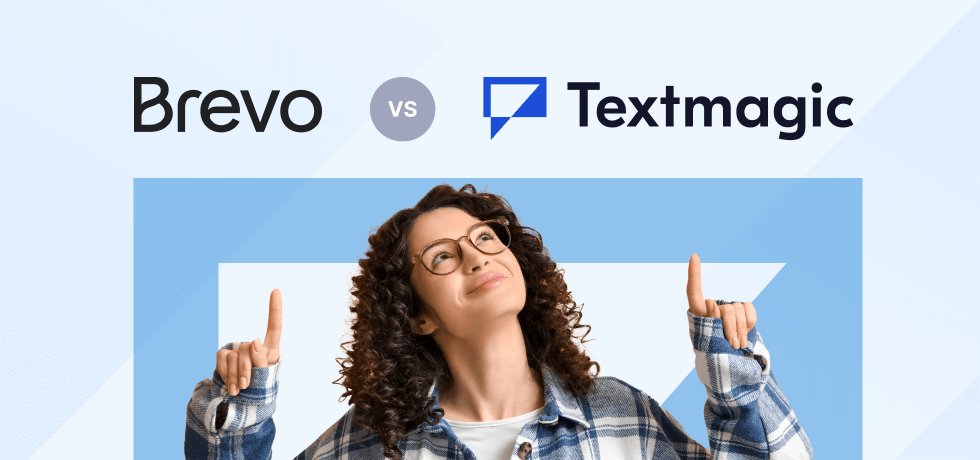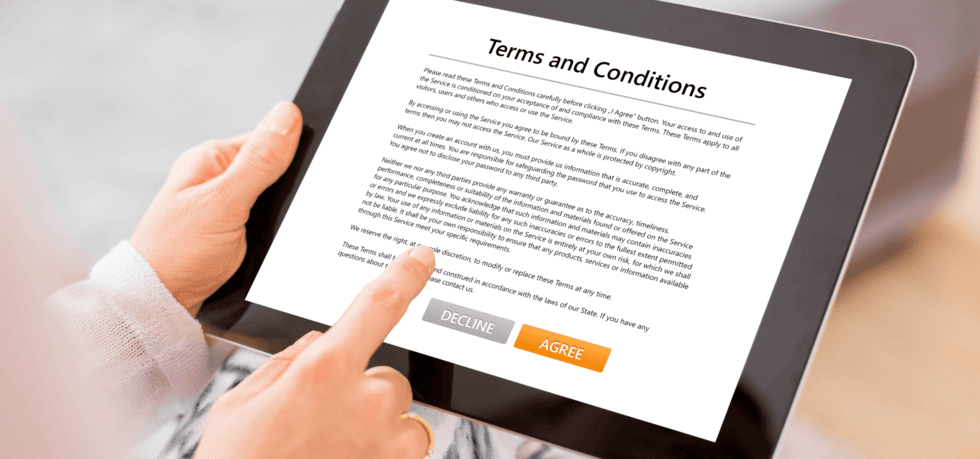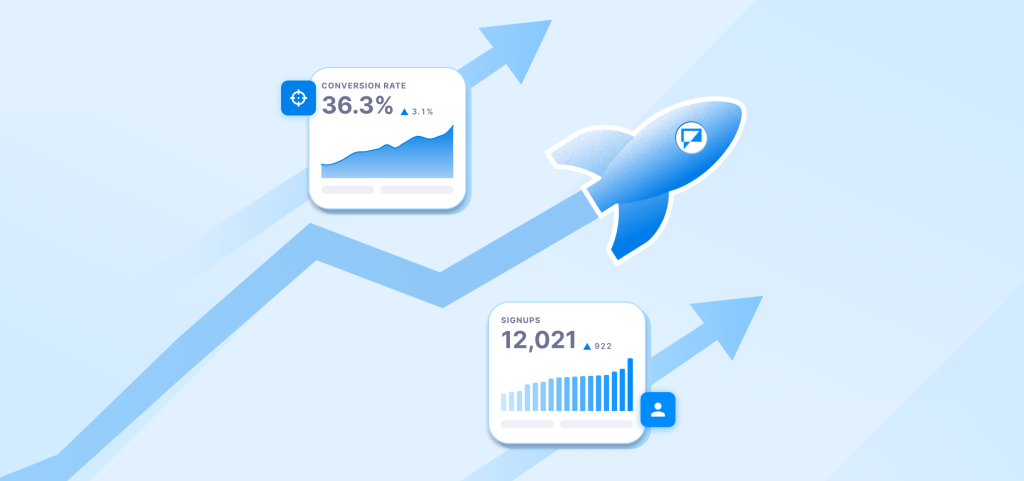
PLG (product-led growth) is gaining popularity as the go-to-market (GTM) strategy for companies that want to use their product as a primary growth engine.
By putting the product and customer first, SaaS (software-as-a-service) companies can build a sustainable growth mechanism and quickly increase their ARR (annual recurring revenue).
In this article, we’ll examine PLG, how it works, and how to apply it to your SaaS business. We’ll also explore the benefits of this approach and provide actionable steps you can take to start implementing PLG today.
We propose every strategy based on our experience with Textmagic and Touchpoint, for which we have applied PLG principles.
What is PLG?
PLG is a GTM strategy that prioritizes the product experience as the primary driver of business growth. In other words, in a PLG model, the product becomes the primary sales and marketing tool, driving user adoption, engagement, and expansion.
According to recent data, the growth rate of product-led growth companies is 50% year over year, while traditional SaaS companies are growing at a more modest 21%.
Product-led companies experience lower customer acquisition costs (CAC) and, therefore, better CAC payback than sales-led or marketing-led ones.
More insights on this are detailed below.
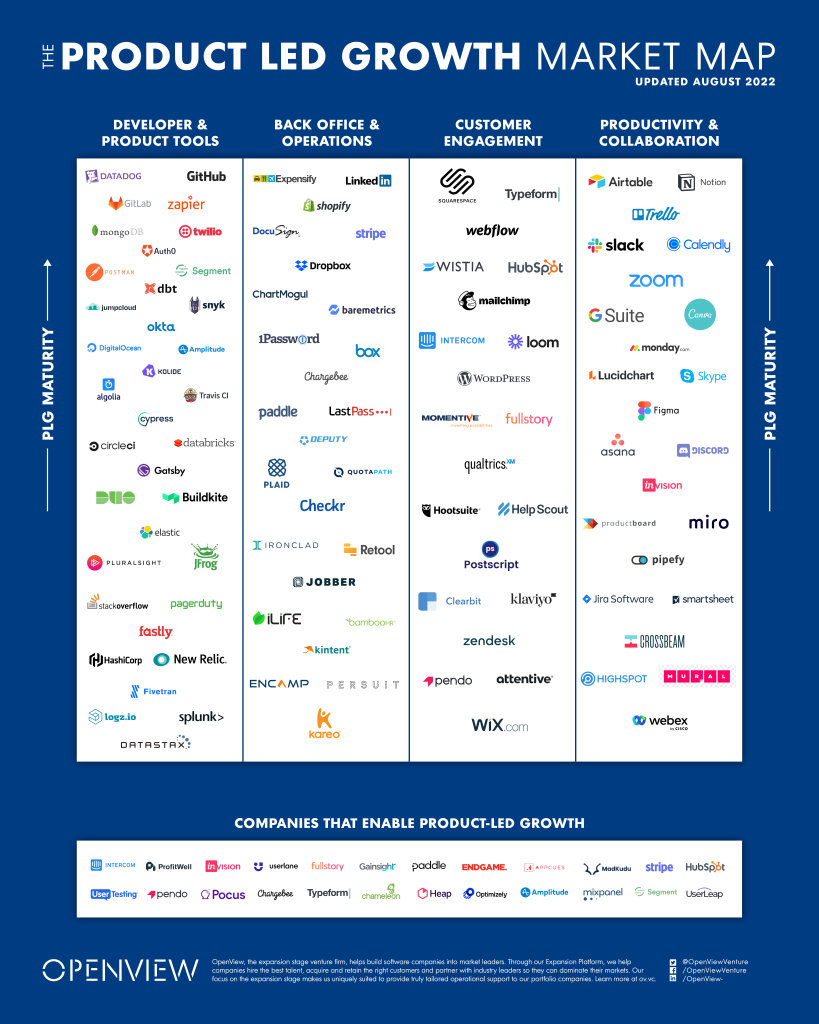
Image source: openviewpartners.com
Product-led growth vs. sales-led growth
Product-led growth (PLG) and sales-led growth (SLG) represent two distinct approaches to driving business growth.
Despite their differences, PLG and SLG share some common ground. They both aim to grow revenue for the business by focusing on meeting customer needs and solving their problems.
However, they vary in how they achieve these goals, their cost structures, and how quickly they can expand. PLG and SLG also differ from customer-led growth, which prioritizes aligning business strategies with customer feedback to drive satisfaction and growth.
Here’s a comparative table highlighting the key differences between PLG and SLG:
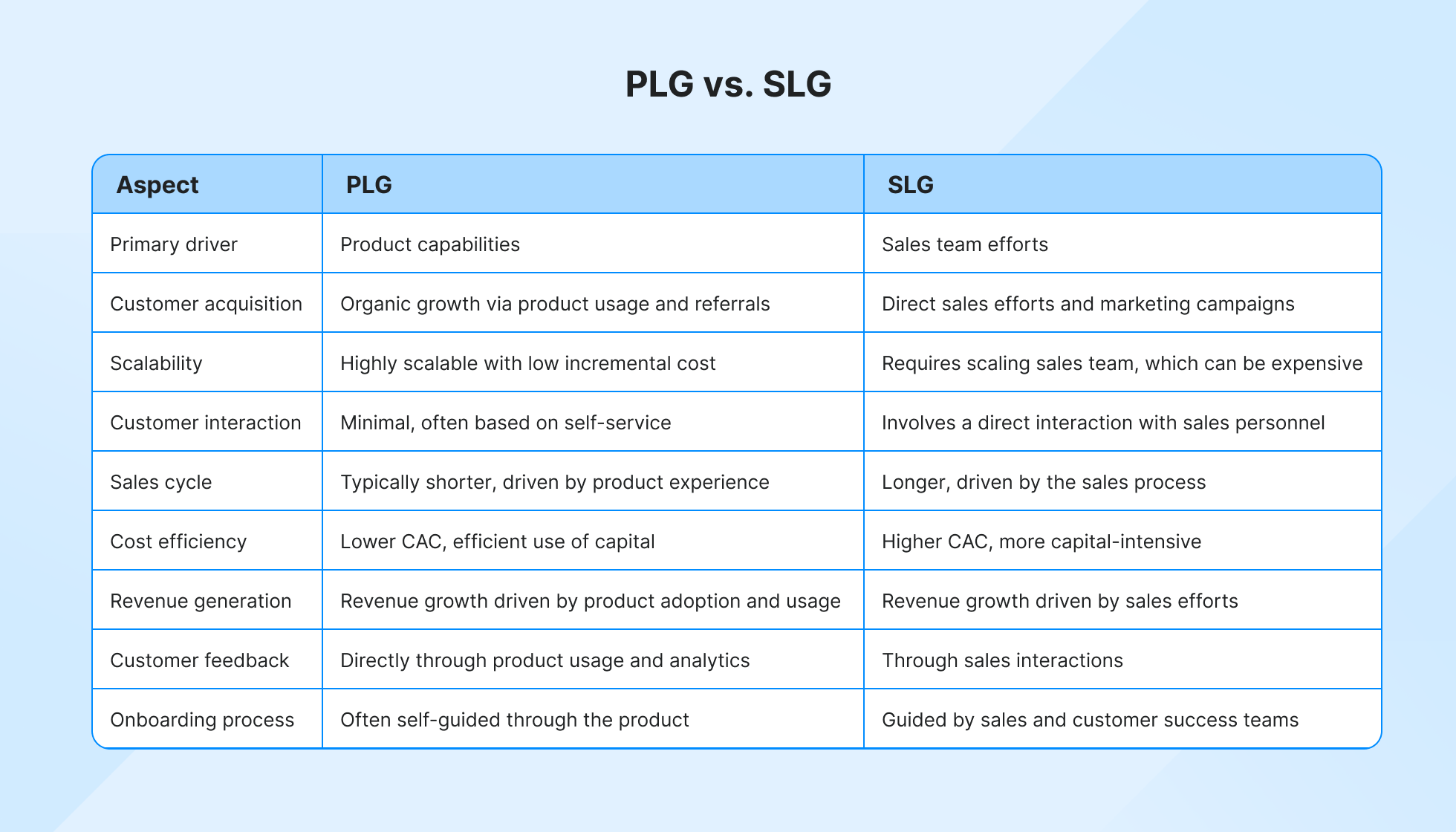
For years, the business-to-business (B2B) industry believed there was a clear distinction between PLG and SLG target markets. Many thought PLG worked best for small and medium-sized businesses or tech-savvy buyers, while SLG was seen as the only way to scale a business serving enterprise customers.
A new hybrid approach combines the best of both worlds — product-led sales (PLS). PLS recognizes that while a great product can attract customers, a personal touch is sometimes needed to seal the deal.
Here are some of the benefits of PLS.
- Faster growth: PLS drives rapid customer acquisition and revenue expansion.
- Improved sales efficiency: Sales teams work with qualified leads, leading to higher conversion rates.
- Scalable model: PLS accommodates growth across various customer segments, from SMBs to enterprises.
Why should you consider product-led growth?
A product-led growth strategy allows users to experience and learn the product at their own pace and is generally suited to simple, inexpensive solutions that are easy to adopt.
The impact of a strong product experience is crucial in the B2B customer journey because it shortens sales cycles and increases customer retention. When companies think about becoming product-led, they typically think offering a free trial or a freemium version of their tool is enough. But PLG is about so much more.
In a PLG model, the product is designed to provide a seamless experience for users, basically making it easier for them to discover, adopt, and expand its usage.
This positive experience can lead to faster decision-making and higher conversion rates, as users are more likely to become paying customers.
A seamless user experience and a personalized onboarding process that accurately presents all of the product’s capabilities truly draws users in and keeps them loyal to the brand later on.
Here are the main benefits and risks of product-led growth companies:

The three pillars of product-led growth
PLG relies on three key principles to satisfy user needs and deliver consistent value. Alexandra Ilie, our product marketing manager, explains the importance of sticking to these principles as a PLG company:
“PLG isn’t just a buzzword — it’s a transformative strategy that places the product and customer experience at the heart of your growth engine. At Textmagic, we’ve seen firsthand how a well-executed PLG approach can rapidly increase user adoption and drive sustainable revenue growth. By focusing on delivering value before capturing it, we’ve not only lowered our customer acquisition costs but also built a loyal user base that advocates for our product. If you want your SaaS business to thrive, embracing PLG principles is essential.”
We will discuss each principle and then provide a checklist you should follow to ensure that you meet them.
But first, here’s a quick overview:
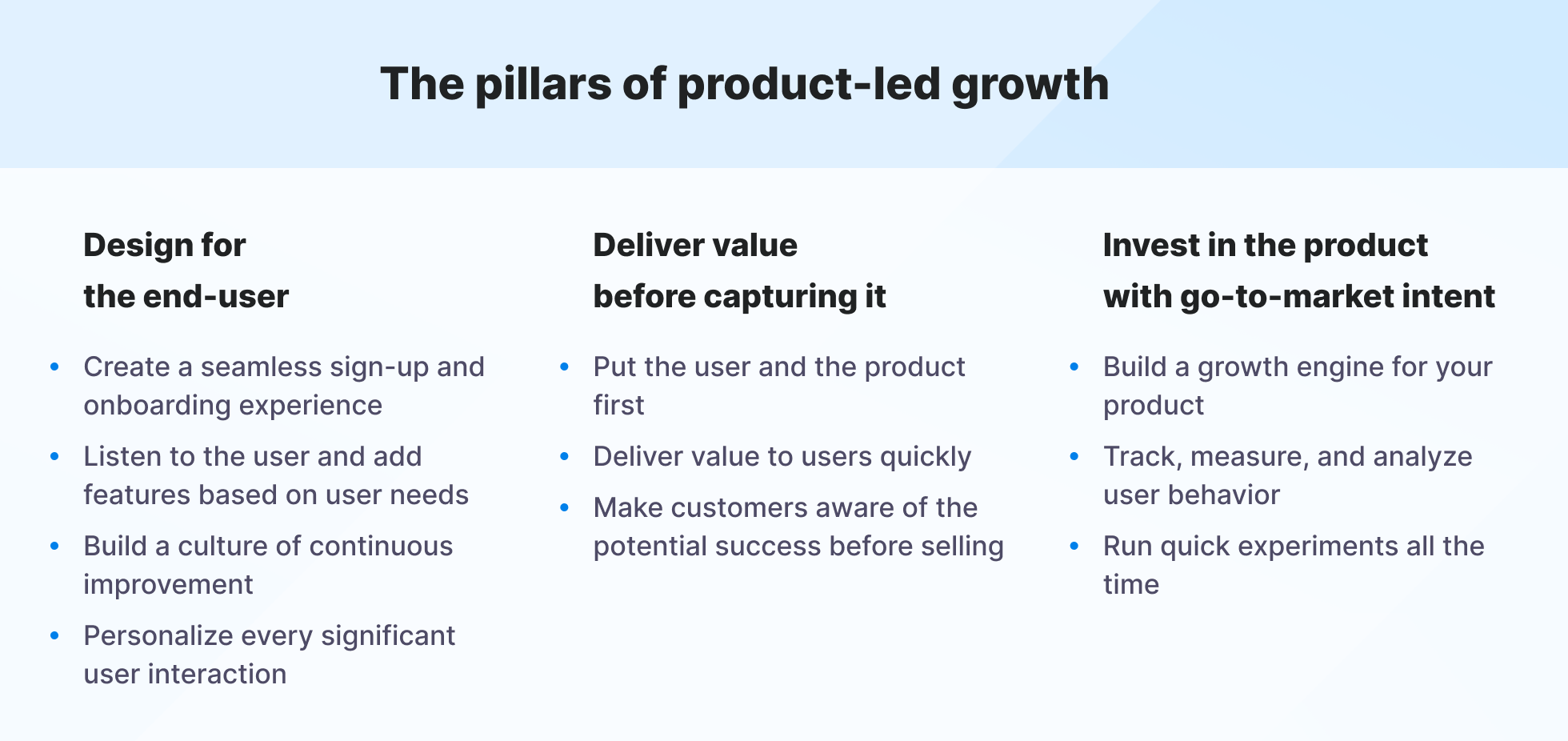
Pillar #1: Design for the end-user
When designing for the end user, it’s essential to consider usability, accessibility, and design. Here are some examples of this principle applied to Textmagic.
Seamless sign-up process
Users are more likely to abandon the sign-up process if it’s too complicated or requires too much information.
We made it easy for users to sign up and get started quickly by only collecting essential information during the sign-up process. We provided a clear value proposition to incentivize them to complete the process.
Personalized onboarding experiences
Personalizing the onboarding experience is crucial to user retention. SaaS companies should use data to personalize the experience to meet each user’s unique needs.
Personalization can include recommending features or content based on the user’s preferences or using their data to customize the interface for their use case. It can help users feel more connected to the product.
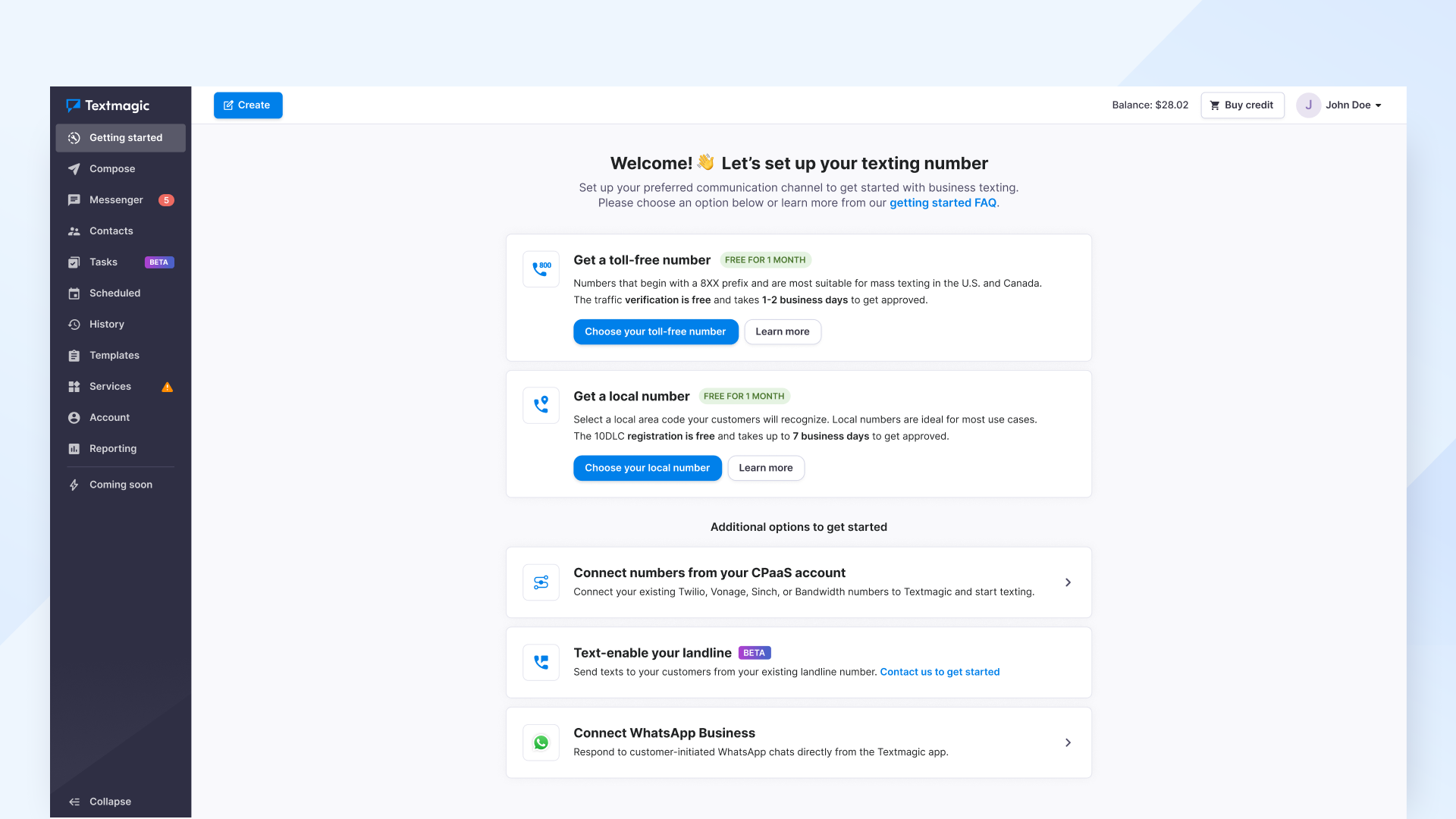
Stellar mobile experience
Optimizing for mobile use and responsive SaaS design is paramount in a mobile-first world. There are several aspects to consider here that would take a whole different article to cover:
- Responsive design for all elements of your site
- Availability of mobile apps for the service/product
- Speed and excellent usability for the service/product
Adding new features based on user needs
We strive to understand our users’ pain points, goals, and priorities by gathering feedback through surveys, user interviews, and support interactions. While redesigning the Textmagic web app, we created an interactive demo for users to leave their thoughts on each screen.

The trick is to look for common themes and patterns in the feedback you receive and prioritize features that will impact most users.
🕵️ Once you’ve identified the features you want to add, test them with a small group before rolling them out to your entire user base.
Pillar #2: Deliver value before capturing value
Strong product-led growth companies convey their value proposition instantly. Here is how you can constantly deliver value to your users.
- Offer a free trial: The simplest way to provide value is to offer full access to your tool. At Textmagic, users can sign up and test all our features at their own pace before committing to the paid version. Other similar examples include freemium models and open-source tools.
- Place customer success before sales success: If a product is easy to use, provides value to the user, and fosters a positive experience, it will lead to increased adoption.
- Address pain points and jobs to be done: There are two ways to approach solving a customer problem — by industry vertical or by job to be done. Most problems people need to resolve are industry-agnostic. Our marketing strategy is based on Jobs to Be Done: From Theory to Practice by Anthony W. Ulwick.
- Invest in rich documentation for automation and integrations: By providing clear and comprehensive documentation, businesses can improve usability, reduce support inquiries, encourage adoption, and enhance collaboration.
- Provide templates and extra tools that make it easier to adopt features: Once you implement a new feature, consider providing extra capabilities that help users easily navigate it.
Pillar #3: Invest in the product with GTM intent
The following three processes help capture market demand and ensure that you tweak your product according to client preferences.
Build your product as a self-serve distribution vehicle
While refining your GTM strategy, you must focus on designing a minimum viable self-serve product experience to drive user activation. Here are a few tips to help you.
- If you want to embrace PLG, you should go through a closed beta phase with a minimum of 10–30 users to confirm product–market fit.
- Test your entire product experience before public launch to avoid vague messaging, poor product experience, and loss of user focus.
- Focus on one strong value proposition early on.
📙 We strongly recommend this guide to help you nail your self-serve experience.
Identify key PLG metrics and use the right tracking tools
Here are the top PLG metrics to focus on:
- Activation rate measures the percentage of users who take a desired action after signing up, indicating effective onboarding
- Expansion revenue tracks additional revenue from existing customers through upgrades, add-ons, and increased product usage
- The churn rate reflects the percentage of users who discontinue product use within a given period
- User retention rate indicates the percentage of users who continue to use your product over a specific period
- The time spent on the product measures how long users engage with the product
- The features used show which aspect of the product users find most valuable
📊 As far as analytics are concerned, platforms like Google Analytics, Mixpanel, Amplitude, and Heap help ensure your data tracking system is scalable and flexible to grow and evolve as your business expands.
Run fast GTM experiments on a smaller scale
One way that we test product-market fit and feature potential is by developing free tools that complement our product or providing free sub-features.
📝 Run tests on user subsets to collect feedback and improve features before making them available to all users.
How to become a product-led company
Congratulations on making it this far! We know this is a lot of information to digest, so we’ve provided a quick checklist to help you become product-led.
1. Make it easy to sign up and adopt the product
Follow these strategies to ensure successful product adoption.
Focus on benefits and value for the user
- Use customer-centric language that focuses on the benefits and outcomes the user will achieve by using the product.
- Include customer testimonials and case studies that highlight the positive impact the product has had on other users.
- Create product demos or videos that showcase the product in action and highlight its key benefits and features.
- Use social proof, such as user reviews or ratings, to reinforce the product’s value.
- Tailor the messaging and positioning to different customer segments to ensure the benefits are relevant and meaningful to their needs.
Introduce the “AHA!” factor early on
- Use interactive elements such as quizzes or assessments to engage users and help them discover the product’s value.
- Provide a product tour or onboarding experience highlighting key features and benefits clearly and engagingly.
Use simple navigation
- Use clear and descriptive labels for navigation links and buttons.
- Limit the number of options in the primary navigation menu to the most important pages.
- Use a consistent layout and design for all pages to reduce confusion.
- Include a search bar on every page to make it easy for users to find what they want.
- Test the navigation with real users to identify any confusion or frustration and adjust accordingly.
Use transparent pricing plans
- List pricing plans, add-ons, metered services, and other costs on the website.
- Provide a pricing calculator or estimator tool that allows users to estimate the cost based on their needs.
- Include any applicable fees or charges upfront in the pricing information.
- Clearly explain any limitations or restrictions on the plans, such as usage caps or feature restrictions.
- Offer a free trial or a limited production version to allow users to try it before they buy.
Make onboarding frictionless (and personalized)
A smooth and personalized onboarding experience can help users quickly understand the value of your product, reduce churn, and increase adoption and retention rates.
- Provide guidance and tutorials and make them easily accessible throughout the onboarding process.
- Incorporate interactive elements (quizzes, surveys, assessments).
- Offer incentives, discounts, or other perks to incentivize users to take action.
- Gamify the onboarding experience.
2. Contextualize features relevant to users
- Understand the user’s pain points and how your product can solve them.
- Showcase features that help users save time, such as automated task assignments or integrations with other productivity tools.
- Present features in the user’s preferred format (visual or audio).
- Tap into user data to personalize the presentation of features.
3. Align your entire team behind your PLG strategy
Fragmentation between departments leads to failure for PLG SaaS companies. Here are the main points to follow to ensure alignment between departments.
🌟 Identify the “North Star” of your PLG strategy and communicate it to your entire team.
Focus your marketing team on these initiatives:
- Create demand instead of just capturing demand
- Build mental availability, not just awareness of your brand
- Emphasize ease of use and generate excitement for the product to build word-of-mouth
- Drive free trials from relevant audiences
- Attract product-qualified leads (PQLs)
- Use SEO, paid media, and content marketing as growth channels
- Create valuable content in easily digestible formats (videos, audio, etc.)
Direct your customer success team to focus on these initiatives:
- Drive adoption at scale with automation
- Actively reach out to users to offer guidance, training, and support
- Identify new use cases for your customers
- Work closely with customers to understand their needs and challenges
- Engage with larger accounts and high customer lifetime value users
- Analyze user behavior to help the product team implement useful features
Focus your product team on these initiatives:
- Create better customer experiences (accent on ease of use and simplicity)
- Help the marketing, sales, and success teams understand what you are building
- Make it easy to communicate the value of the product
- Prioritize outcomes instead of features
- Develop a data-driven view and a product roadmap focused on impact
Direct your sales team towards these initiatives:
- Organically guide customer success instead of sales
- Help customers discover how the product addresses user needs
- Adopt a consultative role within your product-led strategy
Product-led growth examples
Examples of successful product-led companies include Slack, Dropbox, and Zoom.
- Slack grew from 15,000 daily active users to more than 10 million by focusing on a freemium model that allowed users to adopt and share the platform easily.
- Dropbox’s user base grew to more than 700 million by offering a free trial and making it easy for users to invite others to join.
- Finally, Zoom’s intuitive and user-friendly interface has helped it become the go-to video conferencing tool for many businesses and individuals. During the COVID-19 pandemic, its user base grew from 10 million to more than 200 million daily meeting participants in just a few months.
What does the future hold for PLG?
PLG is a game-changer for businesses that want to scale sustainably. By building products that deliver real customer value, companies can drive growth organically through referrals and word-of-mouth.
Looking ahead, several trends are set to shape the future of PLG.
- Broader industry adoption: PLG principles are expanding beyond SaaS into industries like fintech and healthcare.
- Artificial intelligence (AI) and machine learning (ML) integration: AI and ML will enhance user experiences through personalized onboarding, tailored recommendations, and predictive analytics, driving higher adoption and retention rates.
- Advanced user analytics: Sophisticated analytics tools will offer deeper insights into user behavior, enabling real-time optimization of the product experience and improved customer satisfaction.
- Community-led growth: Active user communities will complement PLG strategies, driving word-of-mouth marketing and providing valuable feedback that enhances the product experience.
- Hybrid growth models: Companies will adopt hybrid models that combine PLG with traditional sales and marketing approaches, catering to diverse customer needs and ensuring comprehensive growth.
- Focus on retention and expansion: The emphasis will shift towards retaining and expanding existing customers by continuously delivering value and creating upsell opportunities.
- Evolving customer expectations: As customer expectations rise, companies must innovate and iterate on their products to meet and exceed user demands, ensuring long-term loyalty and satisfaction.
Are you ready to begin your product-led journey?
Product-led growth offers a unique approach to growing your SaaS business. It involves prioritizing users’ needs and creating a product that sells itself.
By applying the principles outlined in this article, your business can achieve sustainable growth, increase user satisfaction, and drive revenue.
Follow our blog to stay updated with the latest PLG strategies and learn more about our product development journey. Discover the main challenges that product-led companies face, how to overcome them, and which tactics to employ in your PLG strategies.
Frequently Asked Questions (FAQs)
Product-led growth puts the product experience at the center of how a business attracts, converts, and retains users.
A product-led approach guides users through features and workflows to increase adoption. The community-led growth relies on engaged users who create content, answer questions, and influence others.
In a PLG strategy, time to value is a key metric. It shows how fast users understand and benefit from the product. A shorter time to value often leads to higher retention and satisfaction.
AI plays a key role in analyzing user behavior to surface actionable insights.
This helps product teams understand how users engage with features, where they drop off, and what parts of the product deliver the most value. This continuous loop of insight and action strengthens product-market fit and supports long-term growth.
Related articles
15 Must-track customer success metrics for accelerated growth
Ignoring customer success metrics is like navigating...
Steal these SMS reminder ideas to avoid losing sales
Every business needs to send reminders to customers ...
Texting your way to success: Conversational commerce SMS
In 2021, the global conversational commerce market w...
Brevo vs. Textmagic: Features and pricing comparison guide
Running a marketing campaign is the first step towar...
How to create 10DLC-compliant Terms of Service and Privacy Policies
Your Terms of Service and Privacy Policy play an int...



